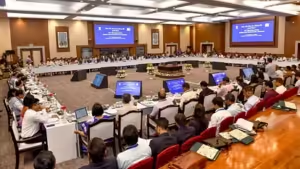GST WEEKLY UPDATE : 21/2023-24 (20.08.2023) By CA Vipul Khandhar

-By CA Vipul Khandhar
- Glossary on e-Invoicing:
- e-Invoicing: ‘e-Invoicing’ means reporting details of specified GST documents to a Government-notified portal e., Invoice Registration Portal (IRP) and obtaining an Invoice Reference Number (IRN). It doesn’t mean the generation of invoices by a Government portal.
- IRP (Invoice Registration Portal): It is a government approved platform where notified persons upload or report Currently, six portals are authorised to generate IRN on reporting of invoices as per Rule 48(4) of the CGST Rules. Reporting invoices and generating Invoice Reference Numbers (IRN) on any of these portals is free of charge.
- IRN (Invoice Reference Number): The unique identifier for every invoice reported on an It is based on the computation of a hash of the supplier’s GSTIN, the financial year, the document type, and the document number.
- AATO (Annual Aggregate Turnover): AATO (Annual Aggregate Turnover) for e-Invoicing is calculated based on the PAN of a taxpayer and the information provided in their GSTR-3B It represents the total turnover of the taxpayer during a financial year and is used to determine the applicability of e-Invoice reporting requirements.
- Enablement: The process of registering and enabling a taxpayer for e-Invoicing on the GST portal, allowing them to report e-Invoices on any of the six Taxpayers are automatically enabled for e-Invoicing based on AATO but if not enabled they need to be self-enabled on the portal (https://einvoice.gst.gov.in)
- GSTIN (Goods and Services Tax Identification Number): A unique identification number assigned to each registered taxpayer under the GST
- GSTR-1: A monthly or quarterly return that taxpayers need to file, which contains details of outward supplies, including e-Invoice
- Debit Note: A document used to record a reduction in the value of a previously issued invoice, typically issued by the
- Credit Note: A document used to record an increase in the value of a previously issued invoice, typically issued by the
- e-Invoice QR Code: A type of two-dimensional barcode that can be read by a digital device and provides information about the invoice. The QR code generated for e-Invoicing includes parameters such as the supplier’s GSTIN, the recipient’s GSTIN, invoice number, date of generation of the invoice, invoice value, IRN, .
- e-Invoice QR Code Verifier App: A mobile application that allows users to scan and validate the QR codes on e-
- e-Invoice FO (Front Office) Portal: The official web portal provided by GSTN where taxpayers can access various e-Invoice-related functionalities, including enablement status, e-Invoice generation, and searching for IRNs. It also provides links to all six IRPs, e-Invoice schema, master codes, enablement status, search IRN functionality, (Link https://einvoice.gst.gov.in )
- JSON Format: JSON (JavaScript Object Notation) is a standard data interchange For e-Invoicing, the invoice data must be uploaded in a predefined schema INV- 01 in JSON format.
- API for e-Invoice Reporting: IRPs offer API-based functionality for reporting e-Invoices. API (Application Programming Interface) is a set of protocols for building and integrating software
- B2B Invoices: These are invoices issued in a business-to- business E-invoicing requirements in India currently apply to B2B invoices for certain taxpayers, based on their annual turnover.
- ERP System: Enterprise Resource Planning (ERP) system is a type of software used by companies to manage their day- to-day business Taxpayers can continue to generate invoices from their current ERP system, but details of all such B2B invoices need to be uploaded or reported on an Invoice Registration Portal (IRP) in a notified format.
- OTP: One-Time Password (OTP) is a password that is valid for only one login session or During the registration process on an IRP.
- Section 10(1) (ca) of the IGST (Amendment) Act, 2023 by introducing the new clause supply made to Unregistered Person:
- Wherever an unregistered recipient provides the details of the address for inclusion on the invoice, the place of supply in such cases would be the location of such address recorded in the invoice.
- Where address is not recorded on the invoice, the place of supply would be the supplier’s place of business i.e. where the goods are handed over to the recipient, thereby implying that such cases would be considered as intra-state supply, and CGST and SGST would be levied.
- AAR & Important Judgements:
(i) AAR On ITC Eligible on GST paid for Inward Supply for Fixing of Plant and Machinery to Earth by Foundation or Structural Support for Making Outward Supply of Goods:
(Applicant – Uvee Glass Private Limited)
Applicant has represented that, ITC should be eligible on the GST paid on the inward supply of structural support of the plant and machinery that is used for making outward supply of the goods/services as the same is admissible in accordance with the section 16(1) read with section 17 (5)(d) of the CGST Act, 2017 read with the explanations, As the plant and machinery is intended to be used by the taxpayer for manufacturing of glasses and for such manufacturing activity structural support is must otherwise machine cannot run, therefore, the subject ITC should be eligible.
Applicant has raised query (i)Whether, ITC is eligible on the GST paid on the inward supply of structural support of the plant and machinery that is used for making outward supply of the goods/services?
AAR held that, The eligibility and conditions for taking Input Tax Credit under GST has been mentioned in Section 16 and 17 of the Central Goods and Service Tax Act, 2017. Further, Input Tax Credit shall be available in respect of goods and services or both received by a taxable person for construction of “Plant and machinery” on his own account including when such goods and services or both used in the course of furtherance of business. The expression “Plant and machinery” has been defined under Explanation which means apparatus, equipment, and machinery fixed to earth by foundation or structural support that are used for making outward supply of goods or services or both and includes such foundation and structural support but does not include – (i) land, building or any other civil structure; (ii) telecommunication towers; and (iii) pipelines laid outside the factory premises. Thus, as questioned by the applicant, Input Tax Credit of GST paid on the inward supply of structural support of plant and machinery which is used for making outward supply of goods/ services is admissible to the extent of provisions/ conditions laid down in Section 16 and 17 of the CGST Act, 2017.
(ii) AAR On GST Ruling on Tobacco Pre-Mixed with Lime:
(Applicant – Kasar Industries)
Kasar Industries, a registered GST entity, raised the question of how their product “DHARIWAL,” consisting of tobacco pre-mixed with lime, should be classified for GST and Compensation Cess purposes. The ruling sought to determine the accurate classification and associated rates for taxation on this specific product. The applicant’s submission provided insights into the manufacturing process of “DHARIWAL,” which involves the mixing of raw cut tobacco with lime, followed by drying, processing, and packaging. The personal hearing provided additional clarity on the manufacturing flow and ingredients used in the product. However, subsequent to the personal hearing, the applicant decided to withdraw the application due to changes in premises. Conclusion: The GST AAR Rajasthan’s ruling in the Kasar Industries case reflects the dynamic nature of the advance ruling process. Despite the detailed analysis and considerations, the applicant eventually chose to withdraw their application.
(iii) AAR On Common head office for multiple GST Registrant:
(Applicant – Uvee Glass Private Limited)
Uvee Glass Private Limited approached the AAR Rajasthan seeking clarity on several complex GST-related matters. The ruling acknowledges the fundamental similarity between the Central Goods and Services Tax (CGST) Act and the Rajasthan Goods and Services Tax (RGST) Act, highlighting that they share provisions except for certain specific points. The AAR meticulously examined the applicant’s statement of facts, supporting documents, and submissions during the hearing. The issues raised by the applicant were scrutinized in detail, allowing for a comprehensive understanding of the subject matter.
The ruling further elucidates each question posed by the applicant, offering insights based on the provisions of the CGST Act and RGST Act. The applicant’s queries encompassed diverse areas such as ITC eligibility on specific supplies, the permissibility of using a common head office for distinct GST registrants with separate factory addresses, and the interpretation of the timeframe for refund processing as per a specific notification.
The AAR clarifies that matters related to procedural aspects, such as using a common head office for multiple GST registrants, are beyond its purview. Such procedural aspects fall outside the scope of the issues on which the AAR can provide a ruling, as outlined in the CGST Act and RGST Act.
Furthermore, the ruling addresses the query related to the timeline for refund processing. It interprets the time period of 60 days provided under Section 56 of the CGST Act, stating that it pertains to the period from the date of filing an application for refund to the date of credit of the refund amount in the taxpayer’s bank account.
The recent GST AAR Rajasthan ruling pertaining to Uvee Glass Private Limited’s queries stands as a comprehensive guide for businesses navigating the complexities of the GST regime. With insights into ITC eligibility, the usage of a common head office, and the refund timeline, the ruling provides essential guidance for strategic planning and compliance efforts.
Disclaimer:
This publication contains information for general guidance only. It is not intended to address the circumstances of any particular individual or entity. Although the best of endeavour has been made to provide the provisions in a simpler and accurate form, there is no substitute to detailed research with regard to the specific situation of a particular individual or entity. We do not accept any responsibility for loss incurred by any person for acting or refraining to act as a result of any matter in this publication.
(Author is a well known Chartered Accountant in the field of Direct & Indirect Taxes)





